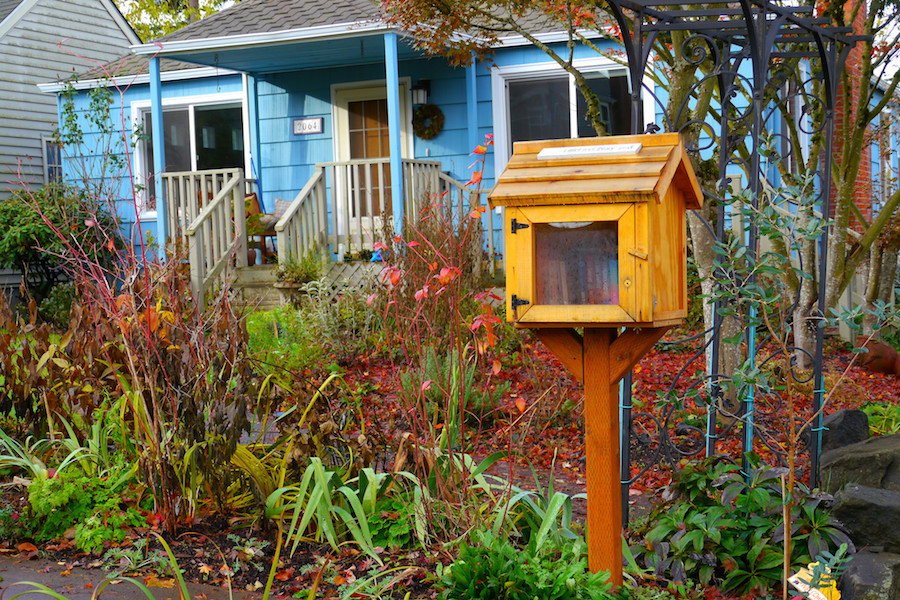Little Free Libraries are simply brilliant. They create a sense of place and connect people while supporting literacy. As Margret Aldrich, author of the Little Free Library Book told Shareable, neighbors started coming over to visit as soon as she put a Little Free Library in her yard.
“When we placed the Little Free Library in front of our house, it was instant,” she says. “The minute we had it in the ground, we had neighbors crossing the street and coming from down the block to stop by and tell is how great it was. People who I had never spoken to came over to chat with us.”
To help people create a Little Free Library in their own neighborhood, the International Literacy Association and Little Free Library created Service Project Kit: Build a Little Free Library. The guide is full of tips for choosing a location, getting started, spreading the word about your library, and more. It also provides tips for teachers interested in putting a Little Free Library in their classroom. Here are the six main steps on how to create a little free library from the guide:
1. Find a Great Location: When choosing a location for your library, look for a visible place with lots of foot traffic. Keep in mind that people of all ages and abilities will be using your library, so make it as easy as possible to access.
2. Build Your Little Free Library: When building your library, you can either design your own, or order a kit from Little Free Library. When deciding which route to take, consider whether your library will have a theme, what you want it to look like, what materials you have access to, the budget you have for materials, and who will be doing the building. Some Little Free Libraries are very simple and some are out of this world.
3. Create a Community of Support: When building your library, ask for support from people in your immediate circle and consider reaching out to local organizations and businesses to donate supplies, plans, or building time. This creates a community-building spirit before you’ve even started and offers others the opportunity to get involved. Having an active, involved community is key to a successful Little Free Library.
4. Spread the Word: To launch your library, consider holding an event, such as a ribbon-cutting or storytelling gathering, complete with refreshments, a book exchange, and an introduction to the library. This is a great way to kick off the community that will support and grow the library. Be sure to alert the local media to your event.
5. Fill the Little Free Library with Books: You can’t have a Little Free Library without books, so before you launch, you’ll need to collect books to seed your library. Two good suggestions for collecting books are to hold a book drive, where friends and community members can donate their gently-used books, or hold a fundraiser, to purchase books from the local thrift store. Note: don’t try to buy new books for your library. It will be far too expensive and is unsustainable. It also takes away from the community spirit. Remember, this is a project you want everyone to participate in.
6. Designate a Steward to Keep the Library Running: Who will be the steward of your library? If you’re reading this, chances are good that it will be you. But, if not, be sure to designate one. A steward makes sure that a Little Free Library is always stocked, clean, and maintained. You will find, however, that a successful Little Free Library belongs to the community and that others, oftentimes anonymously, will restock and tidy up.
Bonus Tips from the Build a Little Free Library guide
- Communicate from the start that this is an effort for the common good—giving offers as much satisfaction as taking.
- Thank people in writing and in person. That’s why having a library-building event or welcoming party can be so valuable.
- Keep a suggestion box or notebook in the library so that anyone can offer comments, recommendations, or requests.
- Use book plates where donors and sharers can tell why they contributed the book and what they value about it. You can design and print your own or download them at littlefreelibrary.org/downloadtemplates/.
- Remember, it’s not just the content of books but the memories and thoughts books generate that matter.
- Build a backup reserve of books by involving book lovers—book clubs and discussion groups, people who have big home libraries, friends of public libraries, used bookstores, and folks who will thoughtfully patronize thrift stores and yard sales. The more people on your support team, the better!
- Follow littlefreelibrary.org/ourblog/ for additional tips on maintaining your library.
##
Top photo: Rick Obst (CC-BY). Follow @CatJohnson on Twitter









